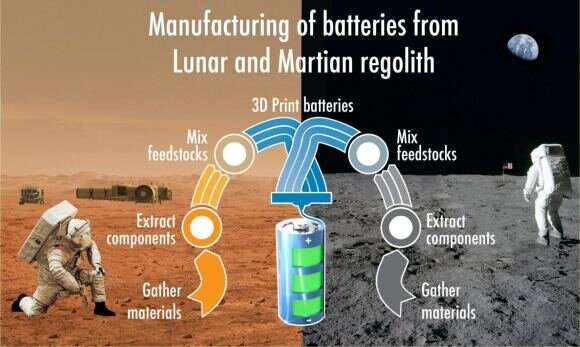But, they'll need batteries for power storage. Those things weigh a lot and cost a fortune to send up from Earth. So, why not simply 3D print their own when they get there?
That's the question a team of researchers at the University of Texas at El Paso (UTEP) and Youngstown State University (YSU) are working to answer. They've teamed up with several NASA centers in a $2.5 million project to explore the idea of 3D printing batteries using local materials.
"UTEP is a seminal partner in this NASA-led project with our long and deep heritage in additive manufacturing," said Eric MacDonald, professor of aerospace and mechanical engineering and associate dean in the UTEP College of Engineering. "UTEP's reputation in 3D printing, material science, and our state-of-the-art facilities were important factors in convincing our NASA partners to pursue this potentially transformative research—for space exploration but for terrestrial applications of batteries as well."
This NASA-led effort is a big step toward adapting the 3D print process for space use. Another goal is to be able to extrude batteries in about any shape needed. Then, they can be fitted into walls of habitats or inside other equipment to save space. And, if it works out, eventually astronauts will be able to print habitat modules, power generators, and other facilities.
What kind of 3D print process to use in space?
The project is looking at two types of 3D print methods. One is called "material extrusion," where the shapes are pushed out of the printer in their final form. The other is "vat photopolymerization" (VPP). The basic material is a vat of liquid photopolymer resin. The machine then uses this material to construct an object, layer by layer. VPP would allow lunar inhabitants to make shape-conformable batteries to fit wherever they're needed. That includes smaller spacecraft, robots, portable power units, and large-scale long-term power systems.
Making batteries using local regolith puts an interesting limitation on what type can be printed. Right now, on the International Space Station, the primary power systems rely on lithium-ion power storage units brought up from Earth. Unfortunately, if people are going to manufacture power storage units on the moon or Mars, they aren't going to be able to use lithium-ion. That's because there's very little lithium available to mine on the moon and Mars. So, what will they use?
The NASA and university teams are looking at sodium-ion technology. Both the moon and Mars do have some amounts of sodium accessible. So, the UTEP research team will be studying sodium-ion battery chemistry and possible printing solutions. After that, they'll test the procedures.
Lunar and Martian batteries tech
NASA, UTEP, and YSU will also work on the extraction of battery materials and precursors for these sodium-ion batteries from lunar and Martian regolith. The university teams already developed and used VPP 3D printing to make composite resin feedstocks for each part of the proposed power storage units.
Technically, that includes the electrodes, electrolytes, and current collectors. The team at NASA's Marshall Ames centers developed and ME 3D printed composite inks for the different battery components. UTEP and NASA's Glenn Research Center will electrochemically test the completed 3D-printed sodium-ion battery components.
"This project with NASA is an opportunity to demonstrate UTEP's expertise in both energy storage and 3D printing," said Alexis Maurel of the UTEP Department of Aerospace and Mechanical Engineering. "Additive manufacturing appears as a unique approach to manufacture shape-conformable batteries to support human operations in space and on the surface of the moon or Mars, where cargo resupply is not as readily available."
Provided by Universe Today



